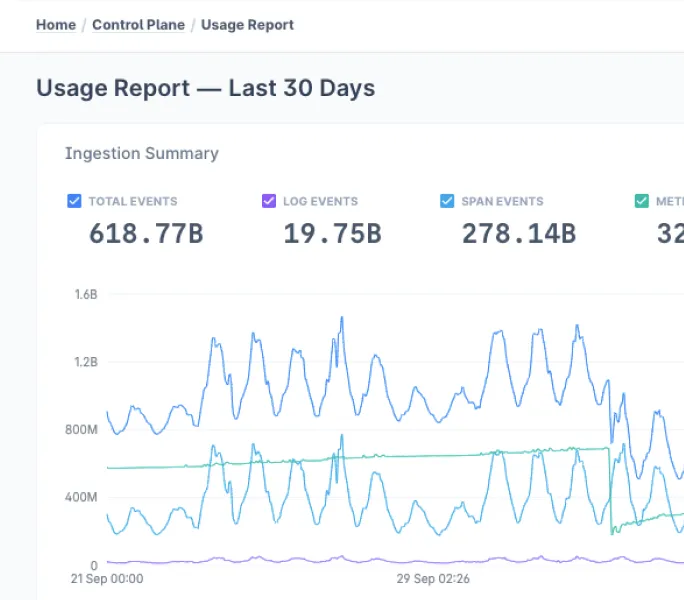Log aggregation is key to modern IT operations. It helps with monitoring, troubleshooting, and improving system performance by bringing together log data from various sources. This centralization helps organizations understand their systems, identify problems early, and keep applications running smoothly.
In this guide, we’ll discuss the essential components, challenges, popular tools, and advanced techniques that define effective log aggregation.
Core Components of Log Aggregation
A log aggregation solution is a multi-faceted system designed to handle the complexities of modern IT environments.
Each component plays a critical role in ensuring that logs are efficiently collected, processed, stored, and analyzed, contributing to a comprehensive observability strategy.
1. Data Ingestion
Data ingestion is the first step in log aggregation, where logs are collected from various sources such as servers, applications, network devices, cloud platforms, and microservices to monitor and enhance application performance.
The ingestion stage includes:
- Agents: Lightweight software agents deployed on host systems to collect log data.
- Collectors: Centralized services that aggregate log data from multiple sources.
- API-Based Integrations: Direct API calls to gather logs from third-party services or custom applications.
2. Data Processing
Raw log data, often unstructured and inconsistent, requires processing before it can be meaningfully analyzed.
The data processing stage includes:
- Parsing: Breaking down log entries into structured fields to enable easier querying and analysis.
- Filtering: Removing unnecessary or redundant log entries to reduce noise and focus on relevant data.
- Enrichment: Adding contextual information, such as geolocation, user identity, or application version, to enhance the value of log data.
- Normalization: Standardize log formats from different sources to create a consistent dataset for analysis.
Data processing transforms raw logs into a format that is both meaningful and actionable, laying the foundation for effective analysis.
3. Data Storage
The storage component is the backbone of any log aggregation system, designed to handle large volumes of data with high reliability and scalability, whether on-premises or in the cloud.
Key considerations include:
- Scalability: The ability to scale storage capacity as log volumes grow over time.
- Retention Policies: Defining how long logs should be retained based on business needs, compliance requirements, and storage costs.
- Search Optimization: Structuring stored data to ensure fast and efficient querying, even as datasets grow.
Choosing the right storage solution, whether on-premises or SaaS-based, is critical for balancing performance, cost, and compliance.
4. Search and Query
The power of a log aggregation tool lies in its search, query, and indexing capabilities.
Effective log analysis requires:
- Advanced Search: Utilizing powerful search functionalities, including regular expressions, Boolean logic, and wildcard searches.
- Filtering: Narrowing down results based on specific criteria such as time ranges, log levels, or source identifiers.
- Statistical Analysis: Applying statistical methods to extract insights, identify patterns, and perform trend analysis.
Quickly and accurately searching through large volumes of log data helps in managing incidents, finding the underlying root cause, and improving performance.
5. Visualization
Visualization tools turn log data into clear, visual formats, making it easier to spot trends, anomalies, and correlations. These tools are essential for debugging and include techniques like:
- Dashboards: Real-time dashboards that display key metrics and KPIs.
- Charts and Graphs: Line charts, bar graphs, and heat maps to represent data trends over time.
- Custom Visualizations: Tailored visualizations that highlight specific aspects of log data, such as error rates or latency spikes. Effective visualization aids in the rapid identification of issues and supports data-driven decision-making.
6. Alerting
Alerting ensures that critical events do not go unnoticed, enabling timely intervention and reducing downtime, and using an open-source tool for alerting can provide additional customization and cost-efficiency.
Key aspects of alerting include:
- Predefined Conditions: Setting thresholds or conditions that trigger alerts when met.
- Real-Time Notifications: Immediate alerts are delivered via email, SMS, or integrated messaging platforms like Slack.
- Incident Management Integration: Seamless integration with incident management tools to streamline the response process.
The Mechanisms Behind Log Aggregation
Now that you’ve got an idea of how log aggregation tools work, here’s a quick rundown:
These tools gather all your log data into one place, making it much easier to keep an eye on system behavior, fix issues, and fine-tune performance.
Here’s how it works:
Event logs are collected through agents or APIs and then processed to pull out the most useful details. They’re stored in a flexible system where you can search and visualize the data. This way, you get clear, actionable insights to keep your systems running smoothly. A good log management tool can make this whole process even more seamless and efficient.
Key Features of Log Aggregation Tools
Log aggregation tools come equipped with features that simplify data management and analysis:
Centralized Data Collection:
Gather logs from multiple sources into a single, unified platform, enhancing your log management solution.
Real-Time Monitoring:
Keep track of logs as they are generated to quickly identify issues and address them proactively.
Scalable Storage Solutions:
Efficiently handle growing volumes of log data, ensuring your system can grow with your needs.
Advanced Search Capabilities:
Use filters, queries, and statistical analysis to find relevant data swiftly and accurately.
Customizable Dashboards:
Visualize key metrics and trends, providing clear insights to support data-driven decisions.
Advantages of Using Log Aggregation Tools
Implementing log aggregation tools offers several benefits that improve your IT operations:
- Enhanced Visibility: Gain a clear understanding of your entire system’s performance.
- Faster Issue Resolution: Quickly identify and address problems before they impact users.
- Improved Security and Compliance: Meet regulatory requirements and protect sensitive data with robust security features.
- Cost Efficiency: Optimize storage and processing costs by centralizing and managing log data effectively.
- Data-Driven Insights: Use aggregated log data to make informed decisions that drive continuous improvement.
Challenges in Log Aggregation
While log aggregation offers significant advantages, it also comes with challenges that need careful management as part of the log management process:
1. Data Volume
The overwhelming volume of logs from modern IT environments can be challenging to handle. This can lead to:
- Storage Strain: High storage costs and performance issues if the volume of logs is not managed efficiently.
- Processing Bottlenecks: Delays in log processing due to the high volume of incoming data, potentially impacting real-time analysis.
Mitigating data volume challenges requires scalable storage solutions and efficient data processing pipelines.
2. Data Format Variability
Logs originate from various sources, each with its format and structure. This variability poses challenges in the following ways:
- Standardizing Log Files: Ensuring consistency across log files from different sources to enable unified analysis.
- Parsing Errors: Handling inconsistencies in log file formats that can lead to incorrect data interpretation.
3. Real-time Processing
Real-time log processing is essential for timely insights but can be resource-intensive. Challenges include:
- Latency: Data ingestion, processing, or alerting delays can hinder real-time responsiveness.
- Resource Utilization: High computational demands for real-time processing can strain system resources.
4. Data Retention
Balancing long-term data retention with cost-effectiveness is a key consideration. Challenges include:
- Compliance: Meeting regulatory requirements for data retention, often necessitating long-term storage.
- Cost Management: Managing the cost implications of storing large volumes of data over extended periods.
Implementing tiered storage solutions and clear retention policies can help manage these challenges.
5. Security and Compliance
Log data often contains sensitive information, making security and compliance critical. Challenges include:
- Data Encryption: Ensure that log data is encrypted in transit and at rest, especially when stored in a centralized location.
- Access Control: Implement strict access controls to prevent unauthorized access to sensitive log data.
- Regulatory Compliance: Adhere to industry-specific regulations such as GDPR, HIPAA, or PCI DSS.
5 Popular Log Aggregation Tools
A variety of leading tools have emerged in the log aggregation space, each offering unique strengths and ideal use cases for centralization.
Last9
Last9 is a cloud-native monitoring platform that helps organizations efficiently monitor complex systems. It reduces alert noise, improves mean time to detect (MTTD) issues, and also offers log aggregation for a comprehensive view of system behavior.
The tool is tailored for scenarios where traditional log aggregation tools struggle, especially with high-cardinality data. It provides powerful real-time analytics to keep your systems running smoothly.
Whether you're using AWS or another cloud platform, Last9 excels in robust log aggregation and analytics. Its capability to handle high-cardinality data makes it perfect for complex applications and demanding environments.
Core Strength: Specializes in handling high cardinality data and real-time analytics.
Ideal for: Use cases involving large datasets where immediate insights are required, particularly in complex, high-traffic environments.
Elastic Stack (ELK)
Elastic Stack (ELK) is a strong choice for organizations seeking a flexible and scalable log aggregation solution.
It consists of:
- Elasticsearch: Handles search and analytics.
- Logstash: Manages data processing.
- Kibana: Provides visualization tools.
While Last9 shines with real-time analytics and high-cardinality data, Elastic Stack offers great versatility and is particularly well-suited for large-scale deployments where a broad range of plugins and extensive flexibility are needed.
Splunk
Splunk is known for its powerful analytics and visualization capabilities, which makes it a preferred choice for organizations that require in-depth log analysis.
Core Strengths: Advanced search capabilities, rich visualization options, and real-time analytics.
Ideal for: Enterprises that prioritize ease of use, comprehensive analytics, and a user-friendly interface.
Splunk also excels in handling a variety of input sources, integrating smoothly with different data streams for a more comprehensive analysis.
Fluentd
Fluentd excels in environments where high-performance log collection and processing are critical, offering extensive customization options.
Core Function: Log collection and forwarding with high performance and flexibility.
Strengths: Open-source, lightweight, and highly configurable, making it suitable for building custom data pipelines. Fluentd is versatile and can be effectively deployed on both Linux and Windows systems.
Ideal for: High-volume log processing and environments with diverse data sources.
Graylog
Graylog is favored by security-conscious organizations that need robust log management and analysis tools tailored to compliance needs.
Core Focus: Security and compliance with advanced features like anomaly detection and user management.
Strengths: Open-source, user-friendly, and designed with a focus on security use cases.
Ideal for: Organizations with stringent security and compliance requirements.
4 Advanced Log Aggregation Techniques
To maximize the value of log data, consider adopting advanced techniques that go beyond basic aggregation and analysis:
1. Log Enrichment
Enriching logs with additional contextual information, such as user IDs, session details, or geo-locations, significantly enhances analysis capabilities.
This technique allows for more granular insights and a better understanding of user behavior or system performance, helping you make more informed decisions about pricing and resource allocation.
2. Machine Learning
Incorporating machine learning algorithms into log aggregation systems can automate the detection of anomalies, patterns, and trends within log data.
Machine learning models can identify subtle issues that might go unnoticed with traditional analysis methods, enabling proactive responses.
3. Log Correlation
Log correlation involves linking related logs from different sources to uncover relationships and dependencies.
This technique is invaluable for root cause analysis, as it allows teams to trace issues across multiple systems or components, including syslog data, providing a holistic view of incidents.
4. Real-time Analytics
Real-time log analytics enable immediate insights and actions, crucial for maintaining system uptime and performance.
Processing and analyzing logs in real-time allows teams to address issues promptly, minimizing the risk of downtime or performance issues.
Conclusion
Log aggregation is more than just a technical necessity; it's a strategic tool that empowers organizations to maintain visibility, enhance security, and optimize performance across their IT environments.
As the volume and complexity of log data continue to grow, the importance of log aggregation becomes even more critical. Organizations must carefully select the right tools and techniques that align with their specific needs, whether it’s handling high cardinality data, ensuring real-time analytics, or meeting stringent security and compliance requirements.
Levitate, a managed Prometheus-compatible service offers SLA guarantees and clawbacks for both read and write workloads. It removes the hassle of maintaining and scaling an in-house metrics setup, allowing engineering teams to focus on more critical tasks.
Levitate supports data ingestion from various open standards, including Prometheus exposition, OpenTelemetry Metrics, OpenMetrics, and InfluxDB.
Book a demo to see how you can cut your Observability TCO by 50%.




